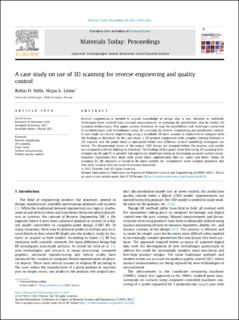| dc.contributor.author | Lemu, Hirpa Gelgele | |
| dc.contributor.author | Helle, Robin H. | |
| dc.date.accessioned | 2021-07-05T07:34:33Z | |
| dc.date.available | 2021-07-05T07:34:33Z | |
| dc.date.created | 2021-04-21T13:12:45Z | |
| dc.date.issued | 2021-03 | |
| dc.identifier.citation | Helle, R.H., Lemu, H.G. (2021) A case study on use of 3D scanning for reverse engineering and quality control. Materials Today: Proceedings, 45(6) | en_US |
| dc.identifier.issn | 2214-7853 | |
| dc.identifier.uri | https://hdl.handle.net/11250/2763275 | |
| dc.description.abstract | Reverse engineering is needed to acquire knowledge of design that is lost, obsolete or withheld. Techniques have evolved from manual measurements, to utilizing the possibilities that lie within 3D scanning technologies. This paper surveys literature to map the possibilities and challenges connected to methodologies and technologies using 3D scanning for reverse engineering and production control. A case study on reverse engineering using a handheld 3D laser scanner is conducted to compare with the findings in literature. In the case study, a 3D printed component with complex internal features is 3D scanned and the point cloud is optimized before two different surface modelling techniques are tested. The dimensional errors of the output CAD design are mapped before the process and results are compared with the findings in literature. The findings of this paper show that using 3D scanning technologies for RE and PC is possible but significant challenges exists in developing accurate surface reconstruction algorithms that deals with point cloud imperfections like i.e., noise and holes. Using 3D scanning for RE purposes is found to be most suitable for components with complex geometry like free-form surfaces that are hard to measure manually. | en_US |
| dc.language.iso | eng | en_US |
| dc.publisher | Elsevier Ltd. | en_US |
| dc.rights | Navngivelse 4.0 Internasjonal | * |
| dc.rights.uri | http://creativecommons.org/licenses/by/4.0/deed.no | * |
| dc.subject | 3D skanning | en_US |
| dc.title | A case study on use of 3D scanning for reverse engineering and quality control | en_US |
| dc.type | Peer reviewed | en_US |
| dc.type | Journal article | en_US |
| dc.description.version | publishedVersion | en_US |
| dc.rights.holder | (C) 2021 Elsevier Ltd. | en_US |
| dc.subject.nsi | VDP::Teknologi: 500 | en_US |
| dc.source.volume | 45 | en_US |
| dc.source.journal | Materials Today: Proceedings | en_US |
| dc.identifier.doi | 10.1016/j.matpr.2021.01.828 | |
| dc.identifier.cristin | 1905593 | |
| cristin.ispublished | false | |
| cristin.fulltext | original | |
| cristin.qualitycode | 1 | |

